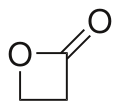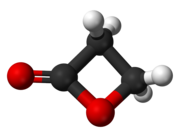| Revision as of 15:13, 17 January 2024 editSmokefoot (talk | contribs)Autopatrolled, Extended confirmed users, Pending changes reviewers, Rollbackers74,550 edits uncited minor factoid from 2018 removed← Previous edit | Latest revision as of 14:56, 5 December 2024 edit undoKisaragiAyami (talk | contribs)144 editsm →Reactions and applicationsTag: Visual edit | ||
| Line 80: | Line 80: | ||
| It reacts with many nucleophiles in a ring-opening reactions. With water ] occurs to produce ] (hydracryclic acid). Ammonia gives the ], which is a commercial process.<ref name=Ullmann/> | It reacts with many nucleophiles in a ring-opening reactions. With water ] occurs to produce ] (hydracryclic acid). Ammonia gives the ], which is a commercial process.<ref name=Ullmann/> | ||
| Propiolactone was once widely produced as an intermediate in the production of ] and its ]. That application has been largely displaced in favor of safer and less expensive alternatives. β-Propiolactone is an excellent sterilizing and sporicidal agent, but its carcinogenicity precludes that use.<ref name="nih"/> It is used to ] a wide variety of viruses,<ref>{{cite journal|doi=10.1111/j.1749-6632.1960.tb40931.x|title=Investigations of the Use of Beta-Propiolactone in Virus Inactivation|year=1960|last1=Logrippo|first1=Gerald A.|journal=Annals of the New York Academy of Sciences|volume=83|issue=4|pages=578–594|pmid=14417982|bibcode=1960NYASA..83..578L|s2cid=6025589}}</ref> for |
Propiolactone was once widely produced as an intermediate in the production of ] and its ]. That application has been largely displaced in favor of safer and less expensive alternatives. β-Propiolactone is an excellent sterilizing and sporicidal agent, but its carcinogenicity precludes that use.<ref name="nih"/> It is used to ] a wide variety of viruses,<ref>{{cite journal|doi=10.1111/j.1749-6632.1960.tb40931.x|title=Investigations of the Use of Beta-Propiolactone in Virus Inactivation|year=1960|last1=Logrippo|first1=Gerald A.|journal=Annals of the New York Academy of Sciences|volume=83|issue=4|pages=578–594|pmid=14417982|bibcode=1960NYASA..83..578L|s2cid=6025589}}</ref> for instance the ], as a step in vaccine production.<ref>{{cite journal|journal=Science|title=Development of an inactivated vaccine candidate for SARS-CoV-2|author1=Qiang Gao |author2=Linlin Bao |author3=Haiyan Mao |author4=Lin Wang |author5=Kangwei Xu |author6=Minnan Yang |author7=Yajing Li |author8=Ling Zhu |author9=Nan Wang |author10=Zhe Lv |author11=Hong Gao |author12=Xiaoqin Ge |author13=Biao Kan |author14=Yaling Hu |author15=Jiangning Liu |author16=Fang Cai |author17=Deyu Jiang |author18=Yanhui Yin |author19=Chengfeng Qin |author20=Jing Li |author21=Xuejie Gong |author22=Xiuyu Lou |author23=Wen Shi |author24=Dongdong Wu |author25=Hengming Zhang |author26=Lang Zhu |author27=Wei Deng |author28=Yurong Li |author29=Jinxing Lu |author30=Changgui Li |author31=Xiangxi Wang |author32=Weidong Yin |author33=Yanjun Zhang |author34=Chuan Qin |date=2020-07-03|doi=10.1126/science.abc1932|volume=369|issue=6499|pages=77–81|pmid=32376603|pmc=7202686|bibcode=2020Sci...369...77G|doi-access=free}}</ref> The principal use of propiolactone is an intermediate in the synthesis of other chemical compounds.<ref name=Ullmann/> | ||
| ] (AKD), a propiolactone derivative that is used in papermaking.]] | ] (AKD), a propiolactone derivative that is used in papermaking.]] | ||
Latest revision as of 14:56, 5 December 2024
"Propiolactone" redirects here. For α-propiolactone, see Methyloxiranone.
| |

| |
| Names | |
|---|---|
| Preferred IUPAC name Oxetan-2-one | |
| Other names
Propiolactone 2-Oxetanone 3-Hydroxypropanoic acid lactone | |
| Identifiers | |
| CAS Number | |
| 3D model (JSmol) | |
| ChEBI | |
| ChEMBL | |
| ChemSpider | |
| DrugBank | |
| ECHA InfoCard | 100.000.309 |
| EC Number |
|
| KEGG | |
| PubChem CID | |
| RTECS number |
|
| UNII | |
| UN number | 2810 |
| CompTox Dashboard (EPA) | |
InChI
| |
SMILES
| |
| Properties | |
| Chemical formula | C3H4O2 |
| Molar mass | 72.063 g·mol |
| Appearance | Colorless liquid |
| Odor | slightly sweet |
| Density | 1.1460 g/cm |
| Melting point | −33.4 °C (−28.1 °F; 239.8 K) |
| Boiling point | 162 °C (324 °F; 435 K) (decomposes) |
| Solubility in water | 37 g/100 mL |
| Solubility in organic solvents | Miscible |
| Vapor pressure | 3 mmHg (25°C) |
| Refractive index (nD) | 1.4131 |
| Hazards | |
| GHS labelling: | |
| Pictograms |   
|
| Signal word | Danger |
| Hazard statements | H315, H319, H330, H350 |
| Precautionary statements | P201, P202, P260, P264, P271, P280, P281, P284, P302+P352, P304+P340, P305+P351+P338, P308+P313, P310, P320, P321, P332+P313, P337+P313, P362, P403+P233, P405, P501 |
| Flash point | 74 °C; 165 °F; 347 K |
| Explosive limits | 2.9%-? |
| NIOSH (US health exposure limits): | |
| PEL (Permissible) | OSHA-Regulated carcinogen |
| REL (Recommended) | Ca |
| IDLH (Immediate danger) | Ca |
| Except where otherwise noted, data are given for materials in their standard state (at 25 °C , 100 kPa).
| |
β-Propiolactone, often simply called propiolactone, is an organic compound with the formula CH2CH2CO2. It is a lactone family, with a four-membered ring. It is a colorless liquid with a slightly sweet odor, highly soluble in water and organic solvents. The carcinogenicity of this compound has limited its commercial applications.
Production
β-Propiolactone is prepared industrially by the reaction of formaldehyde and ethenone in the presence of aluminium- or zinc chloride as catalyst:
In the research laboratory, propiolactones have been produced by the carbonylation of epoxides.
Reactions and applications
It reacts with many nucleophiles in a ring-opening reactions. With water hydrolysis occurs to produce 3-hydroxypropionic acid (hydracryclic acid). Ammonia gives the β-alanine, which is a commercial process.
Propiolactone was once widely produced as an intermediate in the production of acrylic acid and its esters. That application has been largely displaced in favor of safer and less expensive alternatives. β-Propiolactone is an excellent sterilizing and sporicidal agent, but its carcinogenicity precludes that use. It is used to inactivate a wide variety of viruses, for instance the influenza virus, as a step in vaccine production. The principal use of propiolactone is an intermediate in the synthesis of other chemical compounds.

Safety
β-Propiolactone is "reasonably anticipated to be a human carcinogen" (IARC, 1999). It is one of 13 "OSHA-regulated carcinogens," chemicals regarded occupational carcinogens by the U.S. Occupational Safety and Health Administration, despite not having an established permissible exposure limit.
See also
- 3-Oxetanone, an isomer of β-propiolactone
- Malonic anhydride (2,4-oxetanone)
- α-Propiolactone
References
- ^ NIOSH Pocket Guide to Chemical Hazards. "#0528". National Institute for Occupational Safety and Health (NIOSH).
- ^ "β-Propiolactone CAS No. 57-57-8" - US Department of Health and Human Services, Report on Carcinogens, National Toxicology Program, Thirteenth Edition, 2 October 2014. Accessed on 2015-01-03.
- Merck Index, 12th Edition, entry 8005.
- Miller, Raimund; Abaecherli, Claudio; Said, Adel; Jackson, Barry (2001). "Ketenes". Ullmann's Encyclopedia of Industrial Chemistry. doi:10.1002/14356007.a15_063. ISBN 978-3-527-30385-4.
- ^ Miltenberger, Karlheinz (2000). "Hydroxycarboxylic Acids, Aliphatic". Ullmann's Encyclopedia of Industrial Chemistry. Weinheim: Wiley-VCH. doi:10.1002/14356007.a13_507. ISBN 978-3527306732.
- John W. Kramer; Daniel S. Treitler; Geoffrey W. Coates (2009). "Low Pressure Carbonylation of Epoxides to β-Lactones". Org. Synth. 86: 287. doi:10.15227/orgsyn.086.0287.
- Logrippo, Gerald A. (1960). "Investigations of the Use of Beta-Propiolactone in Virus Inactivation". Annals of the New York Academy of Sciences. 83 (4): 578–594. Bibcode:1960NYASA..83..578L. doi:10.1111/j.1749-6632.1960.tb40931.x. PMID 14417982. S2CID 6025589.
- Qiang Gao; Linlin Bao; Haiyan Mao; Lin Wang; Kangwei Xu; Minnan Yang; Yajing Li; Ling Zhu; Nan Wang; Zhe Lv; Hong Gao; Xiaoqin Ge; Biao Kan; Yaling Hu; Jiangning Liu; Fang Cai; Deyu Jiang; Yanhui Yin; Chengfeng Qin; Jing Li; Xuejie Gong; Xiuyu Lou; Wen Shi; Dongdong Wu; Hengming Zhang; Lang Zhu; Wei Deng; Yurong Li; Jinxing Lu; Changgui Li; Xiangxi Wang; Weidong Yin; Yanjun Zhang; Chuan Qin (2020-07-03). "Development of an inactivated vaccine candidate for SARS-CoV-2". Science. 369 (6499): 77–81. Bibcode:2020Sci...369...77G. doi:10.1126/science.abc1932. PMC 7202686. PMID 32376603.
- "Appendix B - Thirteen OSHA-Regulated Carcinogens" - Centers for Disease Control and Prevention. Accessed on 2013-11-06.
